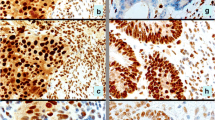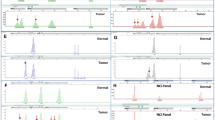Abstract
Microsatellite instability (MSI) testing is useful for identifying patients with hereditary nonpolyposis colorectal cancer and detecting sporadic colorectal cancer that develops through replication error pathways. A pentaplex panel is recommended by the National Cancer Institute for MSI testing, but simplified mononucleotide panels and immunohistochemistry of mismatch repair proteins are widely employed for convenience. This study was to evaluate the MSI status of colorectal cancer in Korean patients. This study included 1,435 patients with colorectal adenocarcinoma subjected to surgical resection. The pentaplex Bethesda panel was used for MSI testing. Seventy nine (5.5 %) carcinomas were classified as MSI-high (MSI-H) and 95 (6.6 %) as MSI-low (MSI-L). BAT-26 and BAT-25 were unstable in 73 and 75 of 79 MSI-H carcinomas, respectively. With the panel comprising these 2 mononucleotide markers, 72 carcinomas were diagnosed as MSI-H, compared to the Bethesda panel data (72/79, 91.1 %). In contrast, BAT-26 or BAT-25 were unstable in only 7 (7.4 %) of the 95 MSI-L tumors. In the panel with 2 dinucleotide markers, D17250 linked to p53 and D2S123 to hMSH2, detection rates were 89.9 % (71/79) for MSI-H and 80.0 % (76/95) for MSI-L carcinomas, compared to the Bethesda panel. Moreover, we compared the frequency of MSI tumor in our patients with those reported previously from Western countries. In conclusion, the frequency of MSI-H appears lower in colorectal cancer patients in Korea. A simplified panel for MSI testing with BAT-26 and BAT-25 seems not effective for the accurate evaluation of MSI status, particularly in MSI-L colorectal carcinomas, in our patients.


Similar content being viewed by others
References
Boland CR, Thibodeau SN, Hamilton SR et al (1998) A national cancer institute workshop on microsatellite instability for cancer detection and familial predisposition: development of international criteria for the determination of microsatellite instability in colorectal cancer. Cancer Res 58:5248–5257
Umar A, Boland CR, Terdiman JP et al (2004) Revised Bethesda guidelines for hereditary nonpolyposis colorectal cancer (Lynch syndrome) and microsatellite instability. J Natl Cancer Inst 96:261–268
Peltomaki P (2003) Role of DNA mismatch repair defects in the pathogenesis of human cancer. J Clin Oncol 21:1174–1179
Ionov Y, Peinado MA, Malkhosyan S et al (1993) Ubiquitous somatic mutations in simple repeated sequences reveal a new mechanism for colonic carcinogenesis. Nature 363:558–561
Shibata D, Peinado MA, Ionov Y et al (1994) Genomic instability in repeated sequences is an early somatic event in colorectal tumorigenesis that persists after transformation. Nat Genet 6:273–281
Heinen CD, Richardson D, White R et al (1995) Microsatellite instability in colorectal adenocarcinoma cell lines that have full-length adenomatous polyposis coli protein. Cancer Res 55:4797–4799
Gologan A, Krasinskas A, Hunt J et al (2005) Performance of the revised Bethesda guidelines for identification of colorectal carcinomas with a high level of microsatellite instability. Arch Pathol Lab Med 129:1390–1397
Hoang JM, Cottu PH, Thuille B et al (1997) BAT-26, an indicator of the replication error phenotype in colorectal cancers and cell lines. Cancer Res 57:300–303
Cravo M, Lage P, Albuquerque C et al (1999) BAT-26 identifies sporadic colorectal cancers with mutator phenotype: a correlative study with clinico-pathological features and mutations in mismatch repair genes. J Pathol 188:252–257
Dietmaier W, Wallinger S, Bocker T et al (1997) Diagnostic microsatellite instability: definition and correlation with mismatch repair protein expression. Cancer Res 57:4749–4756
Sutter C, Gebert J, Bischoff P et al (1999) Molecular screening of potential HNPCC patients using a multiplex microsatellite PCR system. Mol Cell Probe 13:157–165
Loukola A, Vilkki S, Singh J et al (2000) Germline and somatic mutation analysis of MLH3 in MSI-positive colorectal cancer. Am J Pathol 157:347–352
Perucho M Correspondence Re: C.R. Boland et al (1999) A national cancer institute workshop on microsatellite instability for cancer detection and familial predisposition: development of international criteria for the determination of microsatellite instability in colorectal cancer. Cancer Res., 58:5248–5257, 1988. Cancer Res 59:249–256
Boland R, Goel A (2010) Microsatellite instability in colorectal cancer. Gastroenterology 138:2073–2087
Loukola A, Eklin K, Laiho P et al (2001) Microsatellite marker analysis in screening for hereditary nonpolyposis colorectal cancer (HNPCC). Cancer Res 61:4545–4549
Park JW, Chang HJ, Jung KH et al (2008) Clinicopathologic features of sporadic colorectal cancer with MLH1/MSH2 loss of expression—reduced likelihood of metastases. J Korean Soc Coloproctol 24:175–183
Chapusot C, Martin L, Mungra N et al (2003) Sporadic colorectal cancers with defective mismatch repair display a number of specific morphological characteristics: relationship between the expression of hMLH1 and hMSH2 proteins and clinicopathological features of 273 adenocarcinomas. Histopathology 43:40–47
Park JG, Vasen HF, Park YJ et al (2001) Suspected HNPCC and Amsterdam criteria II: evaluation of mutation detection rate, an international collaborative study. Int J Colorectal Dis 17:109–114
Hampel H, Frankel WL, Martin E et al (2005) Screening for the Lynch syndrome (hereditary nonpolyposis colorectal cancer). N Engl J Med 352:1851–1860
Rusin LC, Galandiuk S (2007) Hereditary nonpolyposis colorectal cancer. In: Wolff BG, Fleshman JW, Beck DE (eds) The ASCRS textbook of colon and rectal surgery. Springer, New York, pp 525–542
Schwartz RA, Torre DP (1995) The muir-torre syndrome: 25 year retrospective. J Am Acad Dermatol 33:90–104
Rodriguez-Bigas M, Boland CR, Hamilton SR et al (1997) A national cancer institute workshop on HNPCC: meeting highlights and Bethesda guidelines. J Natl Cancer Inst 89:1758–1762
Thibodeau SN, French AJ, Cunningham JM et al (1998) Microsatellite instability in colorectal cancer: different mutator phenotypes and the principal involvement of hMLH1. Cancer Res 58:1713–1718
Vasen HFA, Moeslein G, Alonso A et al (2010) Recommendations to improve identification of hereditary and familial colorectal cancer in Europe. Fam Cancer 9:109–115
Jass JR (2004) HNPCC and sporadic MSI-H colorectal cancer: a review of the morphological similarities and differences. Fam Cancer 3:93–100
Popat S, Hubner R, Houlston RS (2005) Systematic review of micro-satellite instability and colorectal cancer prognosis. J Clin Oncol 23:609–618
Lanza G, Gafa R, Santini A et al (2006) Immunohistochemical test for MLH1 and MSH2 expression predicts clinical outcome in stage II and III colorectal cancer patients. J Clin Oncol 24:2359–2367
Samowitz WS, Curtin K, Ma KN et al (2001) Microsatellite instability in sporadic colon cancer is associated with an improved prognosis at the population level. Cancer Epidemiol Biomarkers Prev 10:917–923
Phillips SM, Banerjea A, Feakins R et al (2004) Tumour-infiltrating lymphocytes in colorectal cancer with microsatellite instability are activated and cytotoxic. Br J Surg 91:469–475
Galon J, Costes A, Sanchez-Cabo F et al (2006) Type, density, and location of immune cells within human colorectal tumors predict clinical outcome. Science 313:1960–1964
Agostini M, Enzo MV, Morandi L et al (2010) A ten markers panel provides a more accurate and complete microsatellite instability analysis in mismatch repair-deficient colorectal tumors. Cancer Biomark 6:49–61
Zhang L (2008) Immunohistochemistry versus microsatellite instability testing for screening colorectal cancer patients at risk for hereditary nonpolyposis colorectal cancer syndrome: the utility of microsatellite instability testing. J Mol Diagn 10:301–307
Suraweera N, Duval A, Reperant M et al (2002) Evaluation of tumor microsatellite instability using five quasimonomorphic mononucleotide repeats and pentaplex PCR. Gastroenterology 123:1804–1811
Laghi L, Bianchi P, Malesci A (2008) Differences and evolution of the methods for the assessment of microsatellite instability. Oncogene 27:6313–6321
Jass JR, Biden KG, Cummings MC et al (1999) Characterisation of a subtype of colorectal cancer combining features of the suppressor and mild mutator pathways. J Clin Pathol 52:455–460
Mori Y, Selaru FM, Sato F et al (2003) The impact of microsatellite instability on the molecular phenotype of colorectal tumors. Cancer Res 63:4577–4582
Oliart S, Martinez-Santos C, Moreno-Azcoita M et al (2006) Do MSI-L sporadic colorectal tumors develop through “mildmutatorpathway”? Am J Clin Oncol 29:364–370
Halling KC, French AJ, McDonnell SK et al (1999) Microsatellite instability and 8p allelic imbalance in stage B2 and C colorectal cancers. J Natl Cancer Inst 91:1295–1303
Kohonen-Corish MR, Daniel JJ, Chan C et al (2005) Low microsatellite instability is associated with poor prognosis in stage C colon cancer. J Clin Oncol 23:2318–2324
Wright CM, Dent OF, Newland RC et al (2005) Low level microsatellite instability may be associated with reduced cancer specific survival in sporadic stage C colorectal carcinoma. Gut 54:103–108
Asaka S, Arai Y, Nishimura Y et al (2009) Microsatellite instability-low colorectal cancer acquires a KRAS mutation during the progression from Dukes’ A to Dukes’ B. Carcinogenesis 30:494–499
Yamada K, Kanazawa S, Koike J et al (2010) Microsatellite instability at tetranucleotide repeats in sporadic colorectal cancer in Japan. Oncol Rep 23:551–561
Hatch SB, Lightfoot HM, Garwacki CP et al (2005) Microsatellite instability testing in colorectal carcinoma: choice of markers affects sensitivity of detection of mismatch repair-deficient tumors. Clin Cancer Res 11:2180–2187
Meng WJ, Sun XF, Tian C et al (2007) Microsatellite instability did not predict individual survival in sporadic stage II and III rectal cancer patients. Oncology 72:82–88
Huang YQ, Yuan Y, Ge WT et al (2010) Comparative features of colorectal and gastric cancers with microsatellite instability in Chinese patients. J Zhejiang Univ Sci B 11:647–653
Vilkin A, Niv Y, Nagaska T et al (2009) Microsatellite instability, MLH1 promoter methylation, and BRAF mutation analysis in sporadic colorectal cancers of different ethnic groups in Israel. Cancer 115:760–769
Kim GP, Colangelo LH, Wieand HS et al (2007) Prognostic and predictive roles of high-degree microsatellite instability in colon cancer: a national cancer institute-national surgical adjuvant breast and bowel project collaborative study. J Clin Oncol 25:767–772
Gryfe R, Kim H, Hsieh ET et al (2000) Tumor microsatellite instability and clinical outcome in young patients with colorectal cancer. N Engl J Med 342:69–77
Ashktorab H, Smoot DT, Farzanmehr H et al (2005) Clinicopathological features and microsatellite instability (MSI) in colorectal cancers from African Americans. Int J Cancer 116:914–919
Vasovcak P, Pavlikova K, Sedlacek Z et al (2011) Molecular genetic analysis of 103 sporadic colorectal tumours in Czech patients. PLoS One 6:e24114
Nakayama K, Bayasgalan T, Tazoe F et al (2010) A single nucleotide polymorphism in the FADS1/FADS2 gene is associated with plasma lipid profiles in two genetically similar Asian ethnic groups with distinctive differences in lifestyle. Hum Genet 127:685–690
Tunca B, Pedroni M, Cecener G et al (2010) Analysis of mismatch repair gene mutations in Turkish HNPCC patients. Fam Cancer 9:365–376
De Jesus-Monge WE, Gonzalez-Keelan C, Zhao R et al (2010) Mismatch repair protein expression and colorectal cancer in hispanics from Puerto Rico. Fam Cancer 9:155–166
Acknowledgments
This study was supported by grants from the Korea Health Industry Development Institute (KHIDI Grant No. A101097).
Author information
Authors and Affiliations
Corresponding author
Rights and permissions
About this article
Cite this article
Oh, J.R., Kim, DW., Lee, H.S. et al. Microsatellite instability testing in Korean patients with colorectal cancer. Familial Cancer 11, 459–466 (2012). https://doi.org/10.1007/s10689-012-9536-4
Published:
Issue Date:
DOI: https://doi.org/10.1007/s10689-012-9536-4




